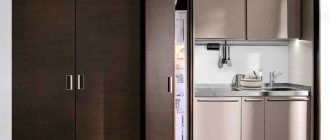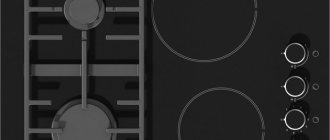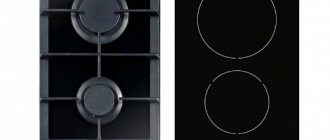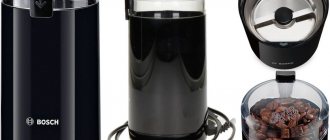General characteristics and functions
Before moving on to the differences between built-in and conventional technology, let's consider their common basic functions:
- Volume. This is one of the most important parameters. The refrigerator must first fit through all doorways and then hold the right amount of food for the entire family.
- Power. The level of energy consumption and the intensity of cooling of products depends on this. Currently, manufacturers are trying to reduce this indicator by all possible methods, from increasing efficiency through the use of other types of compressors, to improving the thermal insulation properties of the housing. The latter helps keep food cold when the compressor is idle and switched off.
- Freezing method. Over the past 5 years, dry freezing has become the most popular - this technology is called “No frost”. Depending on the manufacturer, the name may sound different, but the essence remains the same. Its main feature is the absence of ice on the products and in the chambers, so such refrigerators do not need to be defrosted. In addition, it is convenient to freeze fruits and vegetables for the winter; according to forecasts, No-Frost will soon simply force competitors out of the market. There are other types of freezing, for example, drip freezing, where drops of condensate flow down the back wall and an ice crust gradually forms.
How to install a built-in refrigerator in the kitchen
See also Ceramic countertop for the kitchen: features, pros, cons, how to make it yourself.
see also
“No frost” technology in refrigerators.
Country style kitchen design in a city apartment
Tips for decorating a window in the kitchen
Gray kitchen in the interior. Comparing the pros and cons
How to clean a new refrigerator before turning it on for the first time. Folk remedies and household chemicals
MDF countertops for kitchen units: features, classification, tips for choosing.
Features of the correct choice of voltage stabilizer for a refrigerator
European kitchen design style: distinctive features and interesting design ideas, photos of interior examples
Stylish small kitchen design in 2021
Ceramic countertop for the kitchen: features, pros, cons, how to make it yourself.
Layout of the kitchen as a dining-living room
Connecting the oven to the mains
Features of built-in refrigerators
In stores, among the variety of household appliances, you can find faceless built-in refrigerators with various fasteners on the facade. But in the end you will get the design you need.
Built-in refrigerators are mounted in furniture. This is convenient no matter where it is located - in the kitchen, in the hallway or in any other room. Thus, you completely hide the refrigerator from view and visually increase the space of the room.
The next important factor is that built-in refrigerators are less noisy. Noise reduction is achieved precisely due to the fact that the refrigerator is placed in furniture and is partially isolated from the outside world. Some vibrations are dampened by the design of the cabinet or cabinet in which it is located.
Built-in refrigerator at home
The built-in version is no different from the usual one inside. But from the outside, the impression of an unfinished device is created - the facing panels are partially missing, and fastening elements are located in their place. With their help, the refrigerator door is connected to the doors of the furniture in which it is built. Therefore, you can give any appearance to your refrigerator even long after purchase.
Attention! The cabinet for installing a built-in refrigerator should be larger than the device itself by about 10 cm on each side in width and 25 cm in height and 5-10 in depth. The exact distances will be indicated in the instructions for the refrigerator.
To ensure that when the cabinet doors are opened, the refrigerator door opens with it, sliding or hinge fasteners are used. Otherwise, you will first open the cabinet door and only then the refrigerator door - this is inconvenient.
However, there are other nuances:
- Make sure in advance that there is an outlet in the place where the device will be installed. It will not be very convenient to install an extension cord in an already installed set of furniture. By the way, if necessary, it is convenient to use broaches made of thin cords or wire.
- Moving integrated household appliances is very problematic, especially if the furniture is not of the same type and its design changes depending on its position in the corners, in the center, etc. Therefore, the decision to purchase it must be made at the stage of designing the future interior.
- The cabinet should not be dull. The principle of operation of the refrigerator is that the food gives off heat to the refrigerant, which flows through a system of tubes located inside the device. This heat needs to go somewhere - it goes into the environment. If you install the refrigerator in a confined space, it will overheat. Therefore, the cabinets must provide the possibility of installing built-in equipment and ventilation of the rear wall (or lack thereof).
Types of built-in refrigerators
Devices can be fully or partially built-in. The first type is practically invisible. With a partially built-in device, the entire frontal area is open. This is very convenient when regulating the operation of the refrigerator. Another classification divides models of built-in devices by type of installation.
- Using sliding slides (then the door will slide to the side when the compartment is opened).
- Using hinges (the front is hung on the door).
Also, the devices are:
- single-chamber;
- two-chamber (freezer only).
Built-in refrigerators come in single-chamber and double-chamber types.
See also: MDF countertops for kitchen units: features, classification, selection tips.
Advantages and disadvantages of built-in models compared to conventional ones
It is quite difficult to compare conventional refrigerators with built-in ones. The fact is that both options can be matched to the kitchen design and certain advantages can be found. But let's take an objective look at the advantages and disadvantages of each type.
Advantages of built-in refrigerators:
- Versatility. The lack of connection to the design allows you to install it anywhere, even in the closet in the bedroom, no one will understand that there is a refrigerator there.
- Space saving. The equipment built into the furniture allows it to be used, while combining the point of its installation with an area for storing something, or for other functions.
- The wide range of models on the market will allow you to integrate the refrigerator into any bedside table.
Flaws:
- Built-in models have a slightly higher price than regular ones.
- Difficult to move after installation.
- It is necessary to lay the cable exactly in the place where the device will be installed.
- During repairs, problems will arise in approaching the unit from the side of the faulty unit.
- If you want to buy another refrigerator, you may have problems selecting a model with similar dimensions.
Advantages of conventional refrigerators:
- It is easier to find a suitable option in almost any store. They are more common.
- The cost is slightly cheaper than built-in ones.
- Easy to move or move to another room.
- It is easier to localize and get to the fault during repair.
Flaws:
- If you have made repairs and the model does not fit into the interior, you will either have to put up with it or buy a new one.
Regular refrigerator
Built-in refrigerator
The main differences between built-in and conventional refrigerators
Let's figure out whether built-in refrigerators are so different from ordinary ones in practice, comparing them according to a number of criteria.
- Appearance.
It will take a long time to choose a regular refrigerator so that its lines and shapes fit into the design of the room, and the handle is stylish and comfortable for you. Also, the color options of most models are limited to basic colors (white, stainless steel, gray and the like). Therefore, in a bright room it may look ridiculous.
Built-in models of any household appliance are chosen simply by their internal structure, number of shelves and volume. You create the appearance yourself when ordering a set of furniture.
- Functional.
Both built-in and regular copies can have any functions inherent in this type of technology. The price segment and the manufacturer’s policy play a decisive role here.
- Accommodation.
You can rearrange a regular refrigerator at any time, while a built-in one should be located inside the furniture. Therefore, its placement needs to be thought out in advance.
- Price.
Built-in models often cost a little more than regular ones. However, there are always exceptions to the rules and it may be that a regular model is several times more expensive than a budget built-in one.
Despite the obvious differences, behind them lies the not so obvious question of the device’s maintainability. It’s no secret that domestic power grids are not famous for their quality and voltage stability. Therefore, household appliances are always at risk. So, you can easily turn an ordinary refrigerator the right way around so that the technician can repair it. The built-in model will have to be removed from the place where it is installed - this is an extra waste of time, and possibly money.
Which is better - a built-in refrigerator or a free-standing one?
A built-in refrigerator is good for small kitchens. It is invisible and fits into any interior. The device has excellent sound insulation. It will always look good thanks to the panels. Of course, it is smaller in volume. But for the design and appearance of the room, these models are indispensable.
For a small kitchen, an excellent solution is a built-in refrigerator model.
A freestanding refrigerator is suitable for large kitchens. White color goes well with all the others. The device fits especially well into a space decorated in a high-tech style. Also, a steel-colored device may be suitable.
See alsoEuropean style of kitchen design: distinctive features and interesting design ideas, photos of interior examples
Noise level
All types and models of refrigerators have the same drawback - they are noisy. The question is how much. The noise level depends on a number of factors:
- Compressor type.
- Conditions of compressor parts.
- How level is the refrigerator?
- On the level of vibration and noise insulation of the device as a whole.
- From the design features of placement and fastening of the compressor.
Conventional models are not in any way isolated from the environment, but built-in ones are closed with an external casing, which, if properly mounted and installed, will reduce its overall noise level.
Important! It is worth noting that now almost all household refrigerators operate quietly, and most conventional models do not cause discomfort, even if they are located in the room and not in the kitchen.
Top 5 tips for choosing a refrigerator
As a result of analyzing reviews of different models and communicating with experts, we have selected 5 tips on what to look for when choosing between a built-in and a conventional refrigerator:
- For those who are making major renovations with possible redevelopment, pay attention to built-in refrigerators, because they are convenient to hide in niches and cabinets. This way you will expand the usable space.
- If you need universal appliances, then a regular refrigerator is better suited for this. It is not picky about the installation location.
- If you want your refrigerator to attract attention, hiding it is the best option. In this case, choose built-in models. Also, built-in appliances are well suited for use in offices and other public eating places - they are not conspicuous and do not spoil the official style of the room.
- And for creative individuals and lovers of rearrangements, an ordinary refrigerator will be a salvation when they again want to start living in a new way.
- If the budget for purchasing a device is limited, it is better to spend money on a good model of a regular refrigerator from a trusted brand.
Watch a video about installing a refrigerator
Useful tips and recommendations for choosing
When choosing a device, you should pay attention to the following.
- Dimensions (this is very important. Appliances can vary greatly in size. It is better to first purchase a device of a certain height, width, depth, and then a kitchen set for it).
- Doors (look at their number. Double-chamber doors usually have 2: for the freezer and refrigerator).
- Energy consumption (you need to take a refrigerator with class A+. But the most economical and modern option: A+++).
- Volume (for classic models it is larger than for built-in models).
- Defrosting (it is best to take a freezer with a No Frost function).
- Compressors (the regular type brings the temperature to the required level and turns off. It is the cheapest, but it has disadvantages: it increases energy consumption and reduces resource durability. The inverter increases the temperature and works, consuming only half of its power to maintain it. Its price is much higher more expensive. Linear operates in 2 positions: on and off. It smoothly and gradually moves to one or the other).
- Noise level.
- Humidity control (additional function).
- Alarms (sound during overloads).
- Antibacterial coating (protection against the spread of fungi and bacteria).
Before purchasing a refrigerator, you should pay special attention to the noise level.
IMPORTANT! European assembly is best: Germany, Czech Republic, Great Britain, France. There is no need to take another one. When you receive a product for delivery, you must immediately check how it works. If the condition is not working, it is better to return the purchase immediately. Installation and installation must only be done by specialists.
Among the most famous brands of built-in refrigerators are:
- bosch;
- samsung;
- liebherr;
- atlas.
Built-in refrigerator in the interior of a minimalist kitchen.
See also: Stylish small kitchen design in 2021











